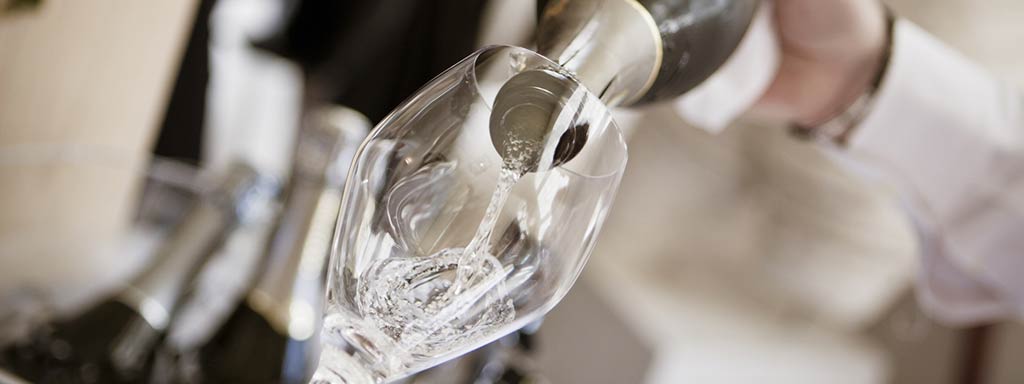
Italian sparkling & semi-sparkling wine
Prosecco is without a doubt one of the best-known Italian export products - in demand worldwide and literally on everyone's lips. We are talking exclusively about the high-quality sparkling wine from Italy's northeast - whose designation of origin has already been regulated for years by ordinances.
The different Prosecco variants (best known frizzante and spumante) differ in each case from the carbonic acid pressure or carbon dioxide content. Here, the Prosecco Frizzante corresponds to the provisions of a sparkling wine, its carbonic acid pressure varies between 1and 2.5 bar - a moussing, restrained and soft wine. In Prosecco, the carbonic acid is the result of a second fermentation in stainless steel tanks. Of course, a number of other quality factors exist, including: The volume of production (artisanal manufactory or large-scale industrial production) as well as the quality of the soil (the best sites are highly sought after) and that of the grapes. The products of the highest value come from prestigious sites such as Conegliano Valdobbiadene, the Rive and last but not least Cartizze. - Gerardo [TS06/22]
"In the process, 'Prosecco' as the name of the grape was erased from the keyword catalog - it may from now on be called exclusively 'Glera" - and the following four quality labels were created: Prosecco and Prosecco di Treviso DOCs, the DOCGs of Asolo (formerly Prosecco del Montello and dei Colli Asolani) and Conegliano Valdobbiadene, the latter with the additional indication on the label of certain sub-zones - very famous Cartizze, but less known, but definitely worth knowing the various Rive. " - Gambero Rosso
| All | Prosecco | All | Frizzante & Spumante | |||||||||||||||||||||||||||||||||||||||||||||||||||||||||||||||||||||||||||||||||||||||||||||||||
| All | Frizzante | All | Spumante | |||||||||||||||||||||||||||||||||||||||||||||||||||||||||||||||||||||||||||||||||||||||||||||||||
| All | Spumante Rosato | All | Franciacorta | |||||||||||||||||||||||||||||||||||||||||||||||||||||||||||||||||||||||||||||||||||||||||||||||||
| Franciacorta | Guido Berlucchi | ||||||||||||||||||||||||||||||||||||||||||||||||||||||||||||||||||||||||||||||||||||||||||||||||||
| Franciacorta | Ricci Curbastro | Franciacorta | Villa Crespia | |||||||||||||||||||||||||||||||||||||||||||||||||||||||||||||||||||||||||||||||||||||||||||||||||
| Franciacorta | Magnum | ||||||||||||||||||||||||||||||||||||||||||||||||||||||||||||||||||||||||||||||||||||||||||||||||||

Italian sparkling & semi-sparkling wine
Pro-Secco? Sounds good, doesn't it? One could almost assume that a marketing strategist who has been washed with all sparkling wines came up with this name! 'Pro' already sounds tremendously positive - and who wouldn't be all for a dry drop of 'secco'? Prosecco (more recently Glera) is the name of the grape variety, and it's been around for centuries. Like the sparkling wine, Prosecco frizzante, from Conegliano and Valdobbiadene in the province of Treviso. The vineyards, in which the white grapes thrive on precisely defined hills, are fantastically situated among the sweeping hills north of Venice.
For a long time, the sparkling white wine was nothing more than a rural but delicate, refreshing wine, drunk mainly on the spot - traveling at most as far as Venice. Only in recent years has it been increasingly bottled, and in the meantime it has even advanced to become the new star of the bubbly sky. Late in the morning in the café, he is just as appropriate as in the early evening in the bar; Frizzante as Spumante do well as an aperitif and as a cool refreshment on hot nights.
The wine from the Glera vine is available in three versions: as (rather unknown) still wine, sparkling wine (frizzante) and sparkling wine (Spumante). The classic version is the sparkling wine (frizzante). It is sparkling, refreshing and has a moderate amount of natural carbon dioxide and is also exempt from sparkling wine tax. Many wine drinkers love the moderate effervescence of frizzante. Spumante (sparkling wine), on the other hand, is the version that has a higher concentration of carbon dioxide. A storage time on the bottle of one year gets the Prosecco spumante quite well, it becomes more clearly balanced. The spumante version is always more expensive in price compared to the frizzante, because of the German sparkling wine tax of EUR 1.21 and also because special bottles must be used for the higher pressure.
The sparkling wine (i.e. frizzante) is the classic from the growing zone. Until modern times, winemakers have used the fermentation reignited in spring as the basis for the pearly wine. This has always been its trademark. So do not be irritated if you read again and again that the Prosecco Spumante (sparkling wine) would be the true Prosecco and the Frizzante only something for beginners, it is perhaps gerarde vice versa. This assertion is not consistent with the history of development of this wine, nor with its delicate, fragile aromas. Only the cellar technology of modern times allows the sparkling of white wine. The product is thereby the double amount of carbonic acid zuführt, which in the end in conjunction with the dosage, so the sugar or liqueur addition, the desired flavor should give.
The success of the sparkling wine was foreseeable. The demand for cheap sparkling wine for all was satisfied according to the proven discount recipe. In the classic DOCG hill zone, the vineyards and yields per hectare are strictly limited and monitored. Since the cultivation of the Glera grape is basically possible and legal everywhere, new areas outside the DOC zone with the Prosecco IGT designation (table wine) were quickly added, especially in the flat areas of the neighboring Piave region. The yields per hectare there easily reach double and more grapes per hectare than the 120 quintals/hectare allowed in the DOC area. Since the Glera vine is basically vigorous, its 'exploitation' for industrial wine (processing wine) is easy. High yields do not only stand for cheap prices, but also for inferior qualities. In addition to the optimal ripeness of the grapes, correct yields per hectare, which are usually low, are important factors. The permitted DOC quantities of 120/dz ha are by no means insanely low, healthy soils and vines live here in harmony with nature. For the sake of profit, self-restraint is not welcome, because one hears of yields per hectare that are beyond 300 quintals per hectare. - Gerardo [TS06/22]
